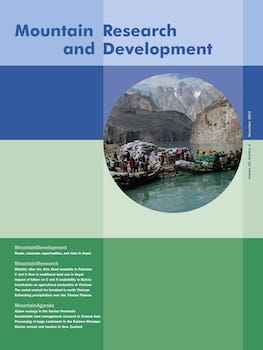Integrated Natural Resource Management in the Highlands of Eastern Africa: From Concept to Practice, edited by Laura German, Jeremias Mowo, Tilahun Amede, and Kenneth Masuki. Abingdon, United Kingdom: EarthScan, 2012. xxix + 306 pp. £ 65.00, US$ 105.00. ISBN 987-1-84971-424-2.
Increasingly, it is being recognized that global resources and processes must be managed sustainably to ensure the continuation of livelihoods. As a collective, we must walk the tightrope between living within the constraints of planetary resource boundaries (Rockström et al 2009) and doing so in a fair and just manner, safeguarding people's most basic needs and satisfying human rights (Raworth 2012). This issue is complex, and there is no single “best practice” that people across the world can adopt to ensure we achieve such noble ambitions. Furthermore, these complex issues are intrinsically linked and so cannot be compartmentalized, with organizations addressing isolated issues that align best with their interests; these issues must be addressed holistically using trans-disciplinary approaches to ensure solutions work synergistically. Thus, it is widely recognized that solutions to these problems need to be tailored to local situations, resulting in increased buy-in from the local populations and increased chances of success. It is here that integrated natural resource management (INRM) has an important role to play, and this book serves as an important source for anyone wishing to commence such work.
The text is divided into 6 chapters, organized to lead the reader through the overarching theories supporting INRM and through ways of incorporating them into practice at a variety of scales. Chapter 1 introduces both INRM and the African Highlands Initiative (AHI) to the unfamiliar reader. This eco-regional research program, underway in the highlands of eastern Africa from 1995, is no longer active, but most of its activities continue under the East Africa program of the World Agroforestry Centre (ICRAF). AHI established benchmark sites across eastern Africa, including single sites in Tanzania and Kenya, and 2 sites each in Ethiopia and Uganda. It is from these 6 case study sites that the book draws its practical insights. Chapter 2 provides an overview of farm-level innovations designed toward increasing local participation, while simultaneously shifting farming systems and practices so they are economically, socially, and ecologically more productive. This methodology is scaled up to watersheds in Chapter 3. At the watershed scale, trade-offs (both social and biophysical) become increasingly apparent, emphasizing the need for INRM. Suggestions of how best to negotiate such trade-offs can be found in the final 3 chapters.
Chapter 4 presents effective and equitable approaches and methodologies to set up and maintain participatory landscape governance and management. It is worth noting the negotiation and conflict resolution techniques that have been developed by AHI to reduce local tensions and conflicts, reconciling locals to increase buy-in and reduce the likelihood of sabotage (some examples of which are provided). Chapter 5 is a “must read” for all research scientists who wish to better engage with local policy-makers to ensure that the impacts of their work continue long after completion of their project. The authors explore varying options of engaging with local institutions, both utilizing them to help ensure that the priorities outlined by the INRM process are obtained and developing them to further advance the support network that the local peoples can turn to in times of hardship. The final chapter is the most ambitious and perhaps stretches the work of AHI too thinly. This chapter explores methods and approaches for scaling up INRM practices from the 6 case study sites to other locations. The chapter focuses on institutionalizing the approaches and innovations so the good practices that have evolved over the course of the book snowball to other areas where they are much needed, incorporating further ideas and methodologies along the way. Unlike in the rest of the book, the authors are unable to support theory here with a wealth of case study data. As a result, the final chapter remains fairly qualitative and somewhat poorly supported with direct evidence. However, as the work has been continued by ICRAF, such evidence may be forthcoming.
Overall, the book is a huge success; it is packed full of useful methodologies and approaches supported by a solid evidence base. The 6 case study sites are used to provide examples throughout the text, providing clarity and credibility to support the theory of INRM. The authors must be commended on their decision to include numerous examples of methodologies and approaches that failed to bring about the desired results, enabling the reader to learn not only from the success of AHI, but ensuring that its failures are not repeated. The book is a wonderful synthesis of the INRM outputs from AHI, summarizing results and findings from 195 publications from the 6 case study sites. The methodologies and approaches that were successful across varying locations are highlighted at the end of each chapter in a series of “lessons learned,” which are invaluable to any organization about to commence such activities. Furthermore, the authors highlight knowledge gaps throughout the book as “missing links.” On this basis, the book provides a valuable platform for future research in INRM. It is a shame that the book, which covers the work of AHI up to 2007, has taken a further five years to be published. This is no doubt due to the sheer volume of work to be summarized, as the AHI team clearly contains numerous hard-working individuals keen to share this work with the wider community. The lag in publication does not detract from the successes of the book, however, as the editors have done a good job in updating ideas and references to ensure that the book is exceedingly relevant in today's world. Hopefully its digestible format will help to widely attract the attention of those involved in INRM, ensuring that the good work of this initiative is continued elsewhere.





